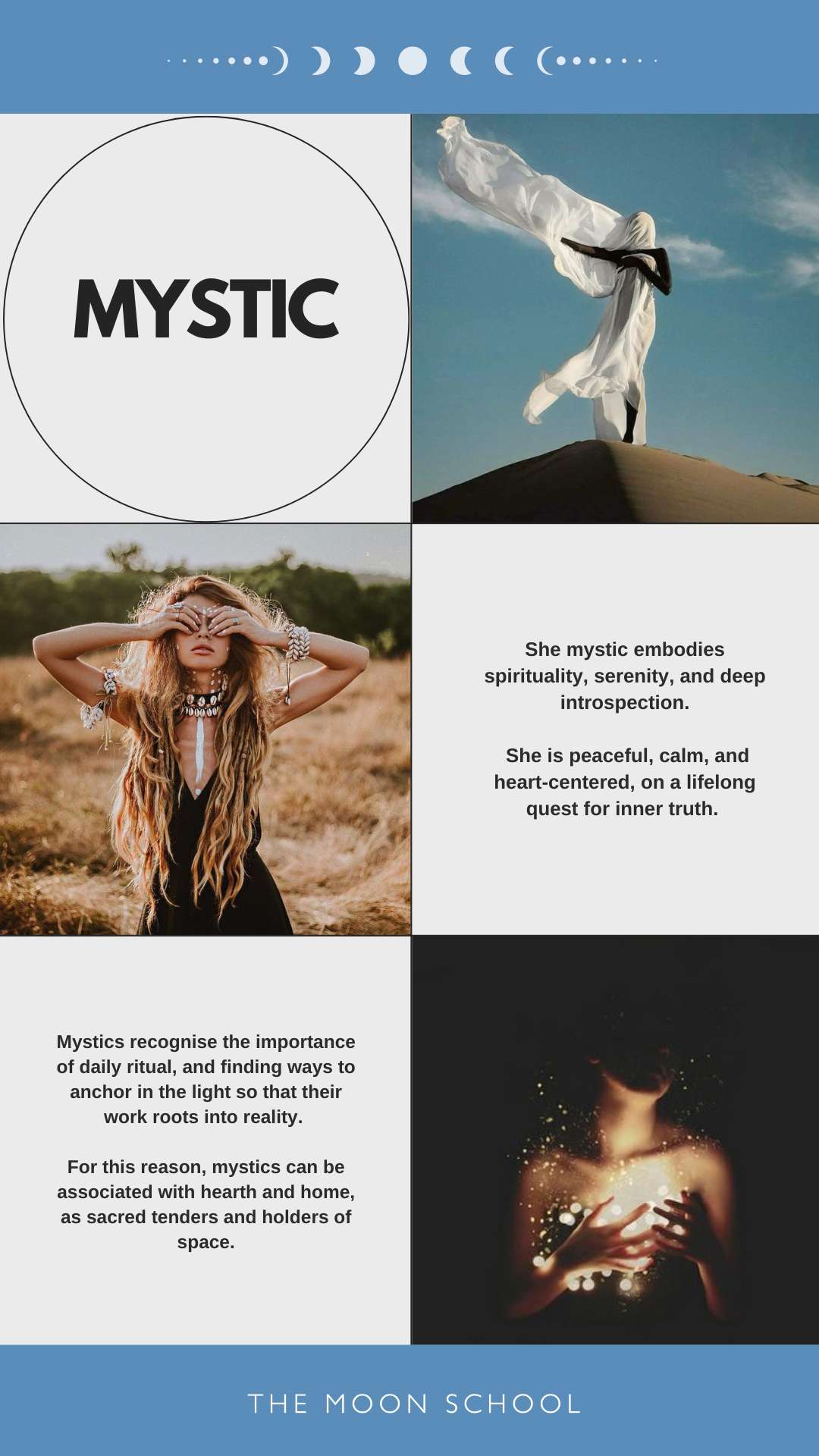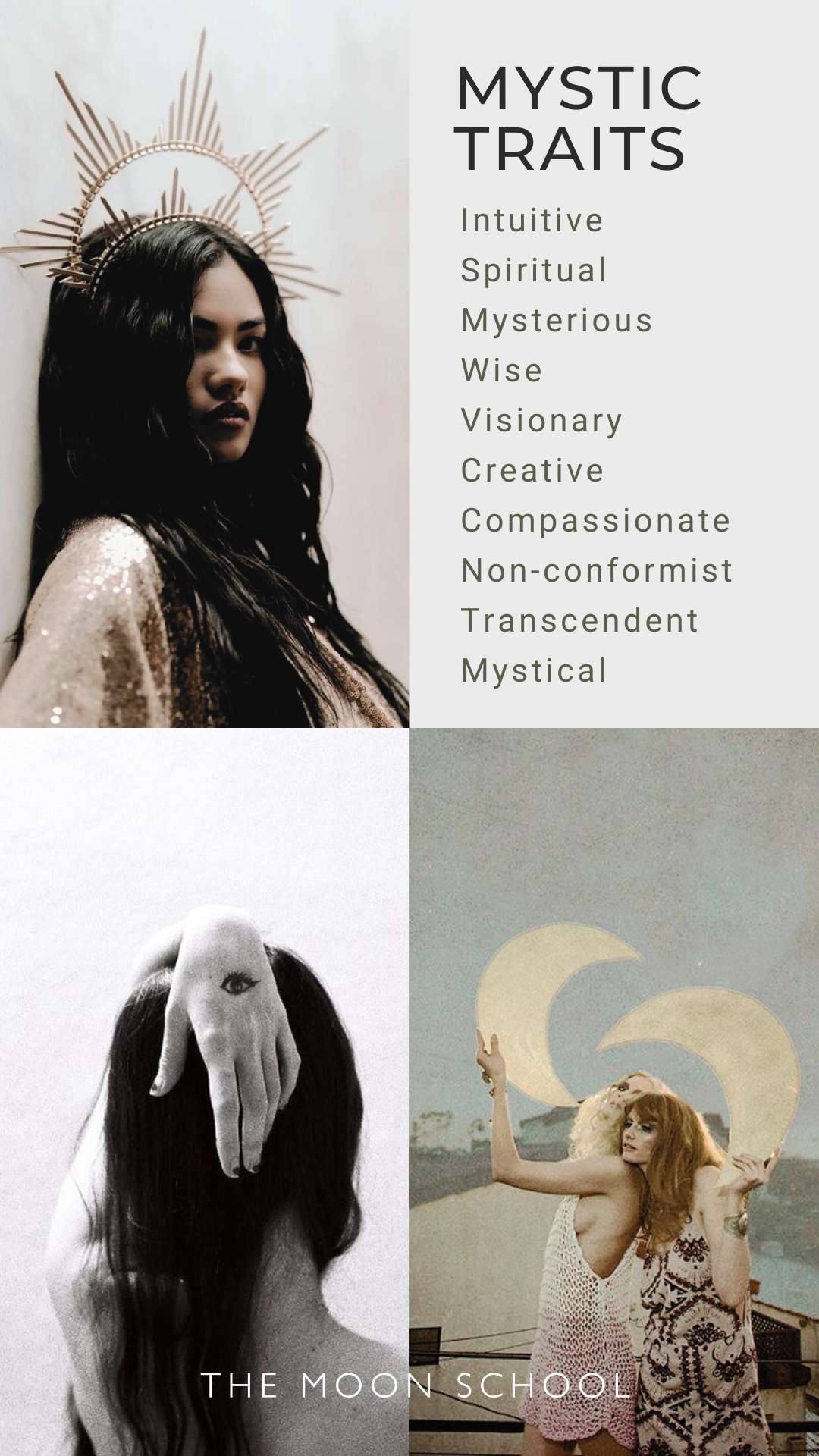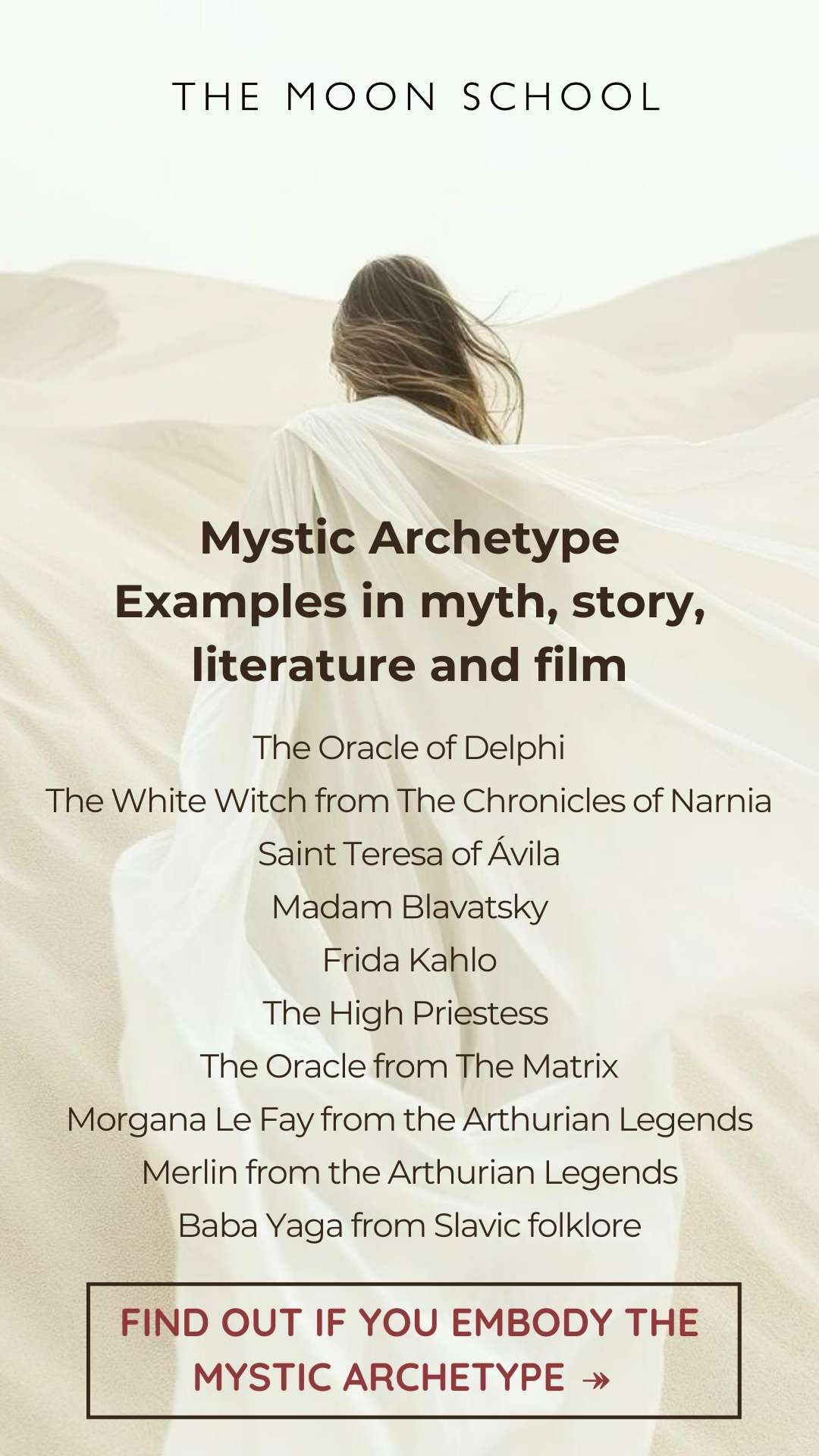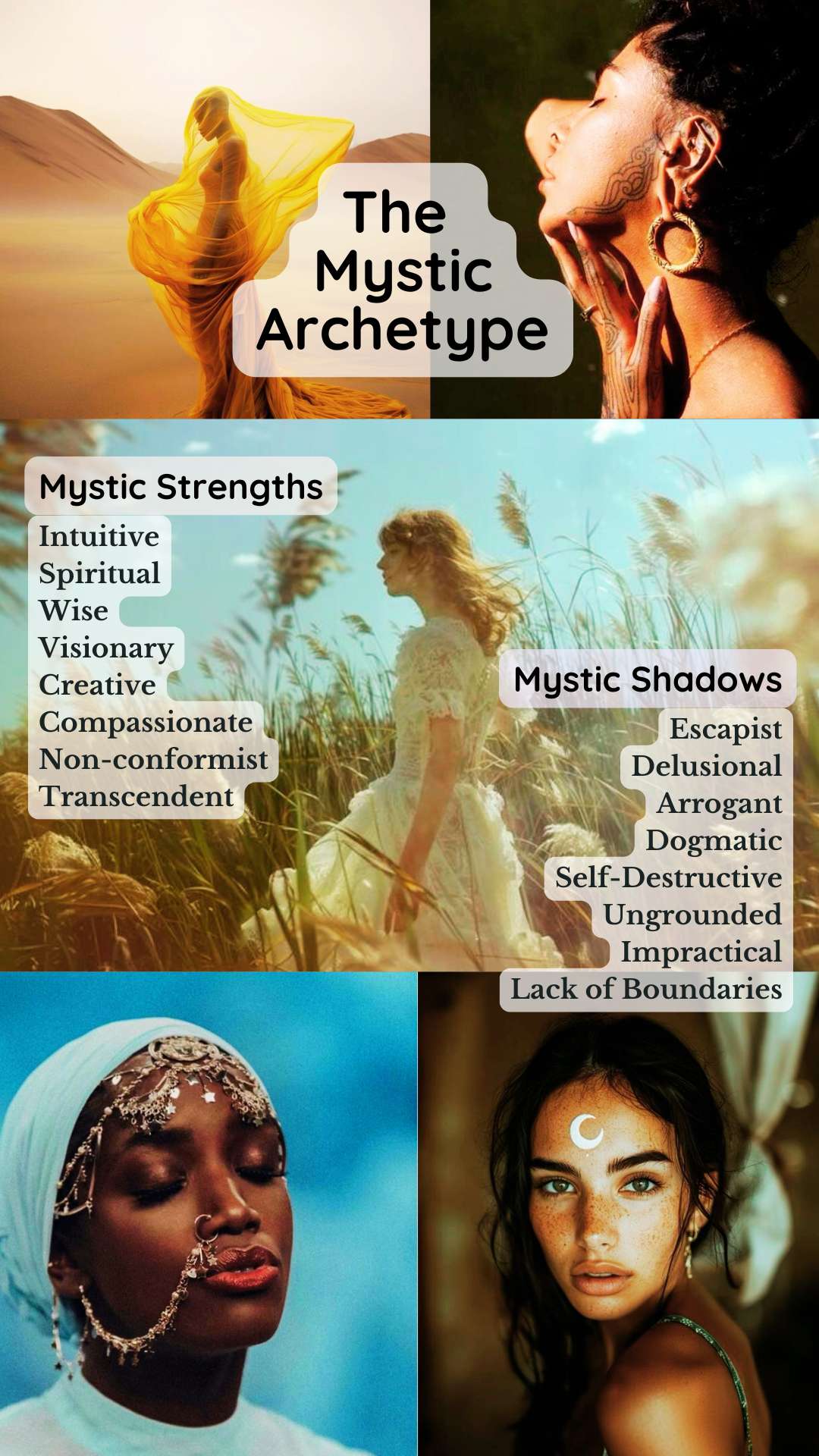The mystic archetype embodies spirituality, serenity, and deep introspection. Also known as the enchantress archetype, her energy is peaceful, calm, and heart-centered. The mystic is on a lifelong quest for inner truth and seeks a connection to the divine.
The mystic woman embodies one of our most powerful female archetypes. She features in the archetypal psychology outlined by Carl Jung, but she isn’t a common figure in mythology, literature, or popular culture.
Yet, aspects of the mystic archetype are starting to reemerge into the world, as increasing numbers of women begin to explore their more magical, and mystical sides.
The mystic is one of the 7 female archetypes. They are:
What is mystic archetype energy?
The mystic archetype is also referred to as the enchantress archetype, or sometimes the priestess. She embodies profound spirituality, mindfulness, serenity, and peace. Her energy is introspective and calm, and she isn’t afraid to dive deep, seeking meaning in the mundane.
Sometimes coming across as cool and detached, the mystic loves time alone.
This feminine archetype tends to feel most at ease when she has solitude and privacy from the rest of the world. Her spiritual practices bring her meaning and purpose. And it’s through inner devotion and connection to her soul, that she tends to feel most complete.
More than almost any other archetype, the mystic has a powerful way of tapping into the frequency of the Universe… To that powerful and elusive force that connects humanity to a higher power.
Guided easily by her intuition, the mystic holds a presence that can feel mesmerizing. Yet unlike the lover archetype (who also possesses this magnetic energy of attraction) women with a dominant mystic archetype can have an otherworldly, even unatainable air.
As one of the most underexpressed female archetypes in our modern Western culture, the mystic is often misunderstood. She has a soft and sensitive heart (which is how she connects to others). Yet because she struggles to assert herself in social situations, she may give the impression of being meek and shy.
But those who know a mystic woman will recognize her deep empathy, and her off-the-chart sensitivity levels! In fact for many mystics, it’s their empathic traits that mean they need to keep their distance from other people. Like veritable sponges, mystics soak up other people’s emotions like water, which can be really hard to handle without the right energetic and emotional protection.
Mystic archetypes often possess healing attributes
Through a combination of insight, spiritual sensitivity, and a desire to be of service, women who embody this energy type often end up supporting other women and men in their own healing journeys.
Her ability to marry the inner and outer world can also make this archetype a reassuring and stabilising influence. Mystics recognise the importance of daily ritual, and finding ways to anchor in the light so that their work roots into reality. For this reason, mystics can be associated with hearth and home. Yet not in the same way as the mother archetype – she’s less of a nurturer, and more of a sacred tender and holder of space.
As mentioned, some aspects of the mystic archetype are starting to emerge into our modern western world. More women are becoming curious about their magical, mystical, or witchy nature, and putting effort into cultivating this part of themselves.
It’s through embodying their inner enchantress archetype, that these women are finding meaning and purpose in a culture that’s starting to become more accepting of these ways.
Also read:What is Feminine Energy?
Traits, Qualities, and Characteristics of the Mystic Archetype
Embodying a very particular kind of divine feminine energy, mystics have an essence that’s deep, spiritual, and also homely, grounded and reassuring.
Here are some examples of the key characteristics, qualities, and traits of the mystic archetype:
Intuitive: Almost goes without saying, the Mystic is deeply intuitive and has a strong sense of inner knowing. Highly attuned to her inner voice, she can often sense things that others cannot
Spiritual: This feminine archetype has a strong spiritual connection, and can easilly tap into the higher realms of consciousness.
Mysterious: Mystics are often shrouded in mystery and secrecy, with a tendency to keep their true nature hidden from others.
Wise: There is a deep, almost otherworldly wisdom posessed by this archetype. Their insight is focused and exacting, and they’re often approached for guidance and advice, by those who seek it.
Visionary: The mystic has a powerful imagination, often able to see beyond the veil. She’s not bound by limitations of the physical world
Creative: The mystic woman is very often a highly creative soul, with a talent for expressing herself through art, music, or other forms of creative expression.
Compassionate: Kindness, compassion and empathy are traits that often go hand, manifesting through this archetype.
Non-conformist: The mystic often rejects societal norms and conventions, preferring to follow her own path. Yet unline the huntress (wild woman archetype) she’s more likely to rebel quietly, through the way she lives her life.
Transcendent: Mystics may be ungrounded and focused on transcending the limitations of the physical world, achieving a higher state of consciousness.
Mystical: Finally, the Mystic is, of course, deeply mystical, with a strong connection to the unseen, deeper levels of existence where spirits, energy, and magic reside. She is an enigmatic force that embodies the mysteries of life, death, and everything in between.
Weaknesses and shadow side of the mystic archetype
The mystic archetype is a powerful and alluring force, but it’s not without its shadow.
Here are some examples of the key weaknesses, negative qualities, and shadow aspects relating to the mystic:
Isolation: Women who walk this path can become isolated and disconnected from others. This may lead to feelings of loneliness and alienation. This can be especially true if you feel like no one else understands your mystical experiences, or you feel like you’re on a totally different wavelength than those around you.
Escapism: Faced with challenges fitting into the ‘real world’ the mystic may use their spiritual practice as a way to escape from reality, avoiding their problems and responsibilities.
Delusion: When you are deeply immersed in your own mystical experiences, it can be easy to lose touch with reality and become lost in your own fantasies and illusions.
Arrogance: At its most extreme, the mystic’s shadow aspects may lead to them becoming arrogant and condescending, especially towards those who don’t share their beliefs or experiences.
Dogmatism: The mystic woman may become rigid and dogmatic in their beliefs, refusing to consider alternative perspectives or ideas.
Self-Destruction: This is not an easy path. So at times, the mystic may engage in self-destructive behaviors, such as substance abuse or extreme asceticism. These may even be disguised as being in support of their spiritual goals.
Ungrounded: Due to her focus on transcending the material plain, this archetype may be very ungrounded and disconnected from her body.
Ineffective or impractical: Becoming so focused on their spiritual pursuits, this archetype may end up neglecting their practical responsibilities. This may make her feel stuck and ineffective in her daily life.
Lack of Boundaries: This archetype may struggle with setting healthy boundaries, leading to overextending themselves or becoming too enmeshed with others.
Burnout: Finally, the mystic may become burnt out or overwhelmed by the intensity of their spiritual experiences, leading to a loss of motivation or interest.
Examples of the mystic archetype in mythology, literature, and popular culture
As mentioned above, the mystic isn’t a very common character in mythology, folklore, film, or literature. But you may catch a glimpse of her presence in characters who have a totally different dominant archetype.
Here are a few famous examples, plus some real-life mystics:
The Oracle of Delphi: In ancient Greek mythology, the Oracle of Delphi was a mystical figure who was consulted for advice and prophecy. Believed to be a conduit to the goddess, she was highly revered for her oracular abilities.
The White Witch from The Chronicles of Narnia: C.S. Lewis’ powerful and mysterious ruler over the land of Narnia. The White Witch is associated with magic and the supernatural and is feared and respected by all who encounter her.
Saint Teresa of Ávila: A real-life Spanish Carmelite nun, prominent mystic and religious reformer. Saint Teresa was active during the Counter-Reformation when she became central to a spiritual, monastic movement.
Madam Blavatsky: Helena Petrovna Blavatsky, known as Madame Blavatsky, was a mystic and author, born in the Russian Empire. She co-founded the Theosophical Society in 1875.
Frida Kahlo: A famous Mexican painter known for her many self-portraits. Due to an accident, she could never have children, so instead gave birth to many, many artworks exploring questions of identity, postcolonialism, gender, class, and race in Mexican society.
The High Priestess: In tarot, the High Priestess represents the mystic archetype. A figure of wisdom, intuition, and spiritual insight, she is associated with the hidden mysteries of the universe.
The Oracle from The Matrix: The Oracle is a mysterious figure who possesses prophetic abilities and guides the protagonist, Neo, on his journey.
Morgana Le Fay from the Arthurian Legends: A powerful sorceress and half-sister to King Arthur, who the archetypal mystic.
ALSO READ: What is a Siren Woman?
Merlin from the Arthurian Legends: Merlin is a wise and mysterious figure who serves as a mentor and advisor to King Arthur.
Baba Yaga from Slavic folklore: Baba Yaga is a powerful, enigmatic, and fearsome witch who lives by herself on the fringes of society. She serves as a mentor and guide to those who seek her out.
10 Ways to Embody the Mystic Archetype
Archetypes are so much more than powerful universal symbols – they are living energetic currents of energy that you can harness in your own life!
Here are 10 ways you can begin to come into contact with the feminine power held within the mystic.
1. Cultivate your intuition
Humans have NO idea of the full extent of our intuitive ability!
Start to trust your gut feelings and listen to that quiet inner voice. Divine guidance actually comes from within. So pay attention to the signs, symbols, and synchronicities that appear in your life, and feel into what they mean.
Then actually take action, based on the guidance you receive.
2. Practice mindfulness and meditation
Yes, it takes time and effort.
Most of us are deeply conditioned to “go, go, go”, for fear of missing out and losing momentum with an already too-fast-paced conveyer belt of life.
But when you actually take time to be present in the moment and focus on your breath, your sensation, and the moment, you’ll find a deep appreciation for peace and calm begins to creep in. This could mean limiting screen time (checking Facebook every half an hour is a surefire way to avoid entering into a meaningful relationship with yourself).
Or it may mean resisting filling every moment of your day with tasks, and sitting still for 20 minutes instead.
3. Explore your spirituality
Discover what you actually resonate with, on a spiritual level.
- Do you believe in God?
- Do you want to?
- Does devotion to the Goddess feel good?
- What could that look like for you?
There’s SO much New Age dogma on the internet right now, and most of it comes with a whole lot of assumptions. But these may not actually be a good fit for you.
Spend time – weeks, months, years – exploring different belief systems, practices, and rituals. Attend spiritual gatherings or ceremonies to figure out what really aligns with your personal values and beliefs.
4. Embrace your creativity
Express yourself through art, music, dance, or other creative outlets. Allow yourself to explore your imagination and channel your inner mystic through your creative endeavors.
6. Cultivate a sense of mystery and allure
Play with creating an air of mystery and intrigue around yourself! Not necessary for the goal of exploring a seduction archetype, but simply for YOU. Dress in a way that reflects your inner mystic, wear jewelry or accessories that have symbolic meaning to you, and cultivate an aura of mystique.
7. Connect to the Moon and stars
Track the cycles of the moon and stars.
Observe the phases of the moon and how they affect your energy and emotions (start here!)
Spend time stargazing and see if you can spot different planets and constellations. If you haven’t already, get your natal astrology chart drawn up, or have a reading with an astrologer.
8. Seek out experiences of transcendence and ecstasy
Explore altered states of consciousness through practices such as yoga, breathwork, or ecstatic dance. Intentionally try to connect with God (or the Goddess, the Universe, Source, or whatever you call the divine).
Seek out experiences that allow you to transcend your normal state of being and connect with the divine.
9. Set clear boundaries
If somebody needs your time or attention, schedule them in for later on, or tomorrow – don’t simply jump to the demands of others. Start to practise the art of saying “no”. As they say, it’s a one-word sentence.
10. BE with nature
Spending time in nature can help you make contact with your inner mystic. Take walks in the woods, sit by a river or lake, or spend time in a garden. Observe the natural world and contemplate its mysteries.
Benefits of embodying the mystic archetype
Still need convincing?! Learning about the feminine archetypes is one of the greatest ways to reach new heights of personal development.
Here are a few benefits you’ll see when you begin to work with this most mystical of the feminine archetypes.
- Increased intuition and psychic abilities
- Greater creativity and inspiration
- Ability to see things from a different perspective
- Heightened sense of spirituality and connection to the divine
- Greater self-awareness
- Inner peace
- Greater sense of purpose, fulfillment, and satisfaction
- Improved mental and emotional health













